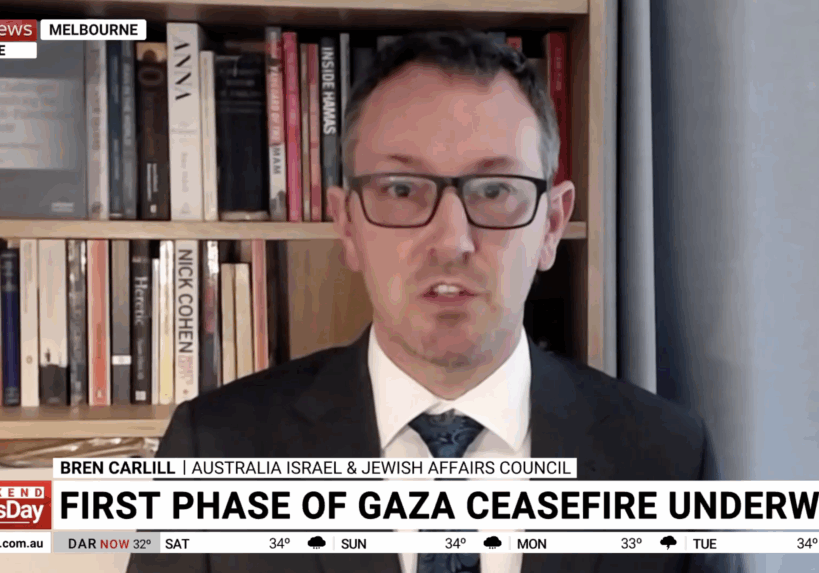FRESH AIR
UPDATES
Five stand-outs about Hamas’ new policy manifesto
May 5, 2017 | Ahron Shapiro

Hamas’ new policy document – which has been mischaracterised as replacing its founding charter – has been described as a softening of its position. But does it really reflect a change in Hamas’ attitude towards Israel or is it merely an attempt to improve its image abroad?
While much has been written about the manifesto, what are the most important takeaways? Here are five – not necessarily in order of importance.
1. Contrary to some reports, Hamas absolutely does not consider it to be a replacement for the Hamas charter.
Hamas took pains to not call the policy statement a charter, but rather “A Document of General Principles and Policies”. Meanwhile, the charter, which goes beyond calling for the destruction of Israel in calling for genocide of the Jewish people, still stands.
This has been reported many times and in many places in the Arabic media, including in media affiliated with Hamas.
For example, Felesteen, a Hamas newspaper, reported
“Hamas denied that the document is an alternative to the Charter of the movement, which was released to coincide with its founding, at the end of the 1980s, stressing that it is a ‘political vision and ideology of the movement.’
(Translation by Microsoft Translator.)
Earlier, an interview with Hamas leader Salah al Bardawil in UK Arabic newspaper Al Quds al Arabi made it clear that “This document (the policy manifesto) will not be considered Hamas’s new substitute Charter”. (Translation by Microsoft Translator.)
2. Moreover, in Arabic, Hamas has been stressing to the Palestinian public that there is nothing new in the policy statement and that Hamas’ goals and its violent methods of attaining them are unchanged.
On May 3, Palestinian journalist Khaled Abu Toameh summarised an interview with Hamas’ international spokesman Hussam Badran that had appeared on the Palestinian website Amad – specifically for Palestinian consumption. Abu Toameh tweeted:

The original article appears at the following link, which can easily be translated using online tools Google Translate or Microsoft Translator.
Even Ha’aretz‘s Amira Hass, a far-Left Israeli journalist who lives in Ramallah and has made a career out of writing articles in wholesale support of the Palestinian narrative, wrote in her analysis published on May 3 (subscription required) that “in terms of its rejection of a Jewish existence in this land, the document is no less hard-line than Hamas’ 1988 charter”.
3. Hamas’ vaunted “acceptance” of a Palestinian state in the West Bank and Gaza is nothing new either, and doesn’t mean it has stopped seeking Israel’s complete destruction.
Hamas leader Khaled Meshal said that Hamas would be willing to accept a Palestinian state in 2012. However, as long as Hamas continues to make Palestinian control over all of the land from the Jordan River to the Mediterranean Sea its unwavering goal, this doesn’t represent a concession at all. It is merely demonstrates the willingness of Hamas to adopt the strategy embodied in the PLO’s infamous Ten-Point Plan of 1974. Also known as the “phased plan”, this was the strategy to destroy Israel in a progressive fashion, imposing Palestinian control over whatever territory it can manage to obtain by whatever methods necessary and simply continue the fight against Israel’s existence from that point forward.
Moreover, AIJAC’S Gareth Narunsky made the point in a May 5 op-ed in Australia’s Daily Telegraph (article on our website) that the passage in the manifesto that accepts a Palestinian state on the 1967 borders is sandwiched between other passages stressing that Hamas rejects stopping the conflict once such a state is established.
Narunsky wrote:
Item 20 of the document may state that Hamas “considers the establishment of a fully sovereign and independent Palestinian state, with Jerusalem as its capital along the lines of the 4th of June 1967 … to be a formula of national consensus”. But, just before this text in the very same item, Hamas makes it clear its goals remain unchanged regardless of any “consensus”: “Hamas rejects any alternative to the full and complete liberation of Palestine, from the [Jordan] river to the [Mediterranean] sea.”
Further, item 25 recommits the group to its murderous ways: “Resisting the occupation with all means and methods is a legitimate right guaranteed by divine laws and by international norms and laws. At the heart of these lies armed resistance.”
Make no mistake – the Palestinian public is quite familiar with how the phased plan works and does not misinterpret Hamas’ statement. Adnan Abu Amer, an academic on Palestinian affairs at a Gaza-based university, wrote recently for the website Al-Monitor regarding Hamas’ expected announcement accepting a Palestinian state, “It would appear that Hamas’ end goal remains Palestinian rule over all of pre-1948 Palestine.”
In a statement by Hamas posted on its website on May 3, Meshal himself “denied any similarities to the experience of ‘Fateh’ in modifying its positions and policies pointing out that Fateh adopted new tactics at the expense of its strategy”.
In other words, Meshal rejects outright that Hamas has moderated its goals by suggesting a fundamental difference between Hamas, which in this policy statement accepted a Palestinian state as a stepping stone to destroying Israel and Fatah, and Fatah, which in accepting the Oslo framework accepted the tactical goal of negotiating with Israel towards the goal of forming a Palestinian state at the expense of the overall “strategy” of destroying Israel entirely. (To be fair to Fatah, some Fatah officials have continued to say their eventual goal is to destroy Israel in stages.)
4. Analysts agree the real purpose of the document is twofold – to attempt to rebrand itself in order to reduce its isolation from both Arab patron states and Western governments.
Hamas has not been shy about this fact, as Meshal said elsewhere in the aforementioned statement from the Hamas website, “We hope this document will have a positive impact on our relations with Egypt and our Arab and international relations.”
Furthermore, in the same Al-Monitor article cited above, Abu Amer solicited comment on the policy document from a Hamas official speaking anonymously. He wrote:
A Hamas Shura Council member based abroad and speaking on the condition of anonymity told Al-Monitor, “The document employs toned-down language designed to break [the movement] out of its international isolation. It is still unclear how the document is going to define ties between Hamas and the Muslim Brotherhood. The regional circumstances may not be favorable for Hamas to remain within the Brotherhood’s sphere, which has hindered its ties with Arab parties who have designated the Brotherhood a terrorist group, such as Egypt. The document may avoid addressing organizational ties between Hamas and the Brotherhood, which were explicitly stated in the Hamas charter.”
Indeed, when it was released, the document did not mention the Muslim Brotherhood, in a clear effort to publicly distance itself from the group. And yet in his interview with the Palestinian press, Hussam Badran said “Our position on the Muslim Brotherhood has not changed from the height of their strength and political presence in the region”.
What is clear is that Hamas is trying to make and keep as many friends as it can. For those who are turned off by its antisemitic charter, it can point to the new policy document which makes a distinction between Israelis and Jews, while those who disagree will have the grossly antisemitic charter and plenty of other Hamas sources to rely on. Again, writing from Hamas’ “heartland” of Gaza, Abu Amer makes this dichotomy clear in his story:
Whereas Hamas’ 1988 covenant recognizes a paramount battle between Palestinians and the Jews, the new document distinguishes among Jews by making it clear that Hamas’ disagreement is with the Israeli occupation only, and “Jews outside Palestine” are not a target or perceived as hostile. Hamas sources who requested anonymity told Al-Monitor that the term “Jews” will be replaced with the term “occupation,” so Israel cannot accuse it of anti-Semitism. A Hamas scholar who declined to be identified expressed his reservations on this change, however, arguing that the Jews, not Israelis or Zionists, are referenced in the Quran.
Western analysts have come to similar conclusions. In a typical example, Kate Harvard and Grant Rumley wrote for the Washington-based Foundation for Defence of Democracies on May 2:
Contrary to reports, this new document neither replaces the charter nor abrogates the group’s founding document. While it is a departure from the faction’s 1988 manifesto, it is not a sign of moderation. Rather, it is an effort to ease international isolation and appeal the rival Fatah party’s base of support.
…
Ultimately, this new document is a balancing act between Hamas’s various Arab and domestic audiences. In not abrogating the charter, Hamas is able to assure its hardline supporters that the original document is intact. Yet, with this new document, Hamas hopes to lure new supporters and international patrons by presenting its softer side.
5. Peace is not presented in the policy statement as a goal of the organisation. However, the “liberation” of Palestine “from the river to the sea” through Jihad, is.
In Amira Hass’ article, cited above, she revealed three ways a leaked draft of the position paper was hardened – not softened – in the final version. One had to do with Hamas’ rejection of peace as a goal. Hass wrote:
According to the draft, “It is inconceivable that any peace in Palestine should be based on transgression against the Palestinian people, usurping their land and banishing them from their homeland.” But the final version says “transgression against the Palestinian people, usurping their land and banishing them from their homeland cannot be called peace.”
This is a fine but clear distinction. In the draft, peace is the subject, and perhaps also the desire, even if on absolutist terms. But in the final version, “peace” is merely a derivative, an imposed, an expected facade.
Even in a document aimed at foreign consumption, Hamas couldn’t bring itself to pretend that it is interested in peace.
Furthermore, consider the context of the writing of the document. It was developed over the last four years during a period where Hamas launched a massive rocket and tunnel offensive against Israel followed by a massive reconstruction of its terror infrastructure. It was also written during a time when Hamas struggled to find funding from its traditional foreign backers.
Conclusion
When you read Hamas’ complete manifesto, it becomes clear that nearly all of it is entirely consistent with the its original Jihadist and antisemitic charter, while the media has been focusing on two small parts of the document – a redirection of Hamas’ antisemitic tropes into anti-Zionist ones and acceptance of a Palestinian state in the West Bank and Gaza.
However, as I’ve shown, Hamas includes these passages for cynical reasons, and shows duplicity on the issue of antisemitism by retaining its charter, while its acceptance of a Palestinian state only represents a minor shift in tactics over how it intends to achieve Israel’s destruction.
Furthermore, Hamas’ motivation for the manifesto is obvious.
Hamas has had trouble finding reliable state sponsorship for several years now
and has been politically hindered over its identity as a branch of the Muslim Brotherhood (part of Hamas’ founding principles) particularly in its crucial relationship with its Gazan neighbour Egypt but also from other Arab states.
In addition, Hamas continues to suffer diplomatic isolation from the West as a recognised terror group.
It’s time to listen to what Hamas itself has admitted to numerous times – that the policy paper is an attempt to solve Hamas’ public relations problems without having to actually change its behaviour, its goals or its support for terror.
Ahron Shapiro
Tags: Hamas
RELATED ARTICLES

Sentencing for antisemitic vandalism “manifestly inadequate”: Joel Burnie on Sky News

“Bittersweet” aftermath of hostage release deal: Joel Burnie on Sky News





















